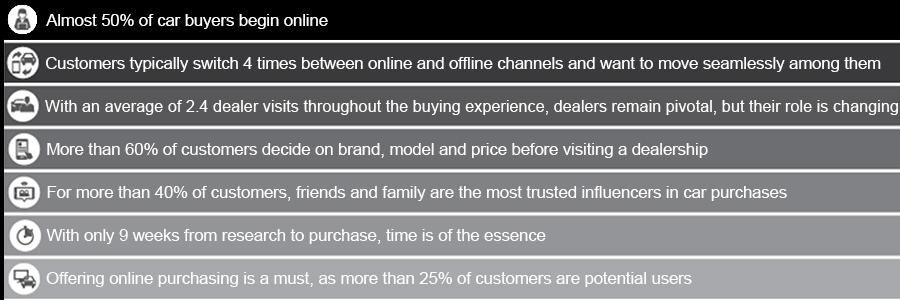We've seen widespread technological innovation in the auto market in the last decade. As we discussed in a recent blog post, adoption of autonomous driving, shared mobility, connectivity, and electric cars has been rapid. What we haven't seen, yet, is much of a change in the automotive sales model. With the exception of Tesla and a handful of purely-online start-ups, most dealers' marketing, operations, sales and service have stayed within the traditional model.
Many analysts, like Bain and Company,
expect this to change. A generation of "digital natives" groomed on customer experiences delivered by companies like Amazon are becoming mainstream car buyers, and these buyers research, select and buy cars differently than their less tech-savvy predecessors.
Bain and Company identified seven ways car buying is changing:

Credit: Seven Ways Car Buying is Changing, by Bain and Company
Customers do a significant amount of research online, move between traditional and digital channels, make more of their decisions before they ever step foot in the door of a dealership, rely on friends and family, make their decisions fairly quickly and even make their vehicle purchases online.
The service and sales model for dealerships will require changes to meet these new expectations. How to stay competitive in a less dealer-centric universe? Dealers need to bolster their presence on channels customers now use, including social media. There will be infrastructure requirements - like a need to invest in IT systems and data analytics to keep the experience seamless as customers cross channels, and garner deep insights that support personalised marketing and service. This can also include offering additional services that keep buyers within your ecosystem after the sale with apps that keep cars connected. The process may also require internal organizational changes, investment in new technology for managing customer contacts, hiring new staff with expertise in these areas, and shifting sales incentives in a way that supports online channels (e.g. vehicle app registrations and even online sales).
In addition the personalised experiences these digital upgrades can find, some brands, especially those with more boutique or aspirational brands and/or vehicles, may want to consider experimentation with "pop-up" brand experiences.
In short, the evolution in the automotive landscape has been dramatic on the technological side, and will need to be just as dramatic when it comes to sales and service. It's why we've opened up new sales channels like
PicklesGO, upgraded our internal systems and marketing campaigns to deliver the most relevant content to our customers, and utilise survey technology like
NPS (Net Promoter Score) to measure our effectiveness and optimise our sales and service processes to provide the best, most personalised experiences for our customers.
05 Oct